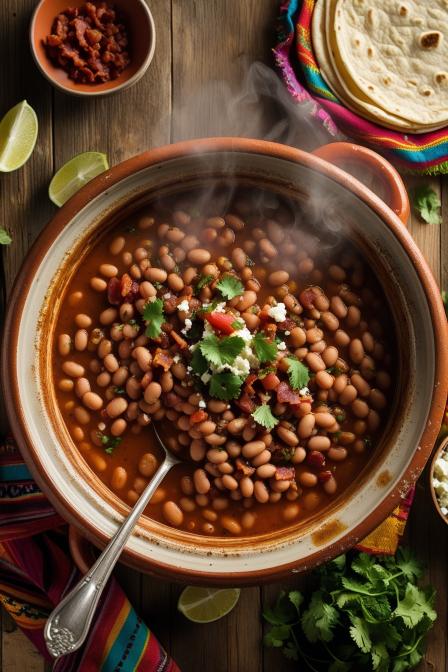Ever tasted a bowl of beans so smoky, spicy, and soulful it made you close yer eyes and mumble somethin’ like “Mmm, ay dios mío”? That’s Charro Beans for ya.
I still remember the first time I had them—sitting on a dusty bench in a tiny roadside taquería somewhere between Monterrey and Saltillo. The beans came out in a clay bowl, steam curling up like incense, the scent of bacon and jalapeño whisperin’ dirty secrets into the air. One spoonful and boom—like a punch of campfire smoke, chorizo grease, and earthy pintos all in one holy bite.
They ain’t just side dish beans, no sir. These are the life of the Mexican cookout. The cowboy beans. Frijoles charros. Named after the traditional horsemen, the charros of Mexico. This is what the vaqueros would simmer in black iron pots by the fire after a long day riding fences.
Nowadays, they show up at carne asadas, weddings, birthdays, Sundays—you name it. And when done right, they’re not just beans. They’re el corazón of the meal.
What Makes Charro Beans So Dang Special?
Charro beans are rustic and generous. Think pinto beans stewed with smoky bacon, spicy chorizo, jalapeños, tomatoes, onions, garlic, cilantro… sometimes even beer. Everything gets simmered into this thick, hearty broth that’s more like a stew than a soup.
They’re loud. They’re wild. They got attitude.
The flavor profile punches in from every corner—spice from chilies, umami from sausage, earthiness from the beans, and a fresh herby zing from cilantro stirred in just before serving. It’s got depth, like a cowboy’s stare.
Best part? Totally flexible. You can dial up the heat, swap in ham hock for bacon, make it soupy or thick, toss in extra aromatics or leave it bare bones. Whatever ya got, the beans’ll forgive.
Let’s dive in.
Ingredients & Smart Substitutions
Here’s the thing: traditional charro beans are made with whatever was around the campfire—so don’t stress if you gotta swap a few things. But if you can get your hands on the real deal stuff, you’re in for a treat.
Ingredient Table
| Ingredient | Purpose | Substitutes / Notes |
|---|---|---|
| Dried pinto beans (2 cups) | Base of the dish | Can use canned, but dried has way more soul |
| Bacon (6 oz) | Smoky richness | Ham hock or pancetta works too |
| Mexican chorizo (4 oz) | Deep spice + grease | Try andouille or spicy sausage if no chorizo |
| White onion (1 large) | Sweet sharp base | Yellow onion works fine too |
| Jalapeños (2) | Classic heat | Serranos for more fire, poblano for less |
| Roma tomatoes (3) | Adds acidity and body | 1 can fire-roasted tomatoes if no fresh ones |
| Garlic (4 cloves) | Bold flavor | More if yer feelin’ feisty |
| Cilantro (½ bunch) | Bright, herbaceous lift | Flat-leaf parsley in a pinch, but not quite the same |
| Bay leaves (2) | Subtle depth | Optional but adds a low hum of flavor |
| Beer (1 cup) | Adds body and a malty kick | Chicken broth or water if avoiding alcohol |
| Salt & Pepper | Balance | Taste as you go—chorizo’s already salty |
| Water or broth (~6 cups) | For simmering | Chicken broth = richer result |
Ingredient Tips
- Dried beans over canned, always. They soak up the flavor better. Plus, the texture… canned beans can get mushy.
- Get fresh chorizo—not the dry Spanish kind. You want the greasy, spicy, uncased stuff that falls apart in a pan.
- Tomatoes need to be ripe. Or roasted. If not, you’re just bringing acidity without depth.
- Bacon should be thick-cut, smoked if possible. Don’t skimp.
Now onto the magic…
Step-by-Step Instructions (With Real-Deal Tips)
Step 1: Soak Yer Beans
Night before, rinse 2 cups dried pinto beans. Cover in water, let soak overnight.
✱ Short on time? Quick-soak ‘em: boil for 2 mins, cover, let sit an hour. But honestly? Slow-soak’s better.
Step 2: Fry the Flavor Base
In a large heavy pot (preferably Dutch oven), cook chopped bacon over medium heat till crispy and the fat renders. Add chorizo, cook till browned. Stir often—chorizo burns fast.
Then in goes your chopped onion and sliced jalapeños. Sauté till onion’s translucent and soft.
Throw in minced garlic, stir 30 seconds till fragrant. If it smells like it’s about to burn, you’ve gone too far.
✱ Tip: Cook these slow. Let the fat render, onions caramelize. Don’t rush. This is your flavor bomb.
Step 3: Add Beans & Liquid
Drain soaked beans. Add to the pot. Stir well to coat in that bacon-chorizo goodness.
Toss in diced tomatoes, bay leaves, and a good pinch of salt.
Pour in beer, then enough water or broth to cover beans by an inch or so. Bring to a boil.
✱ Pro move: Skim any scum that floats up. It ain’t dirt, but it’s not flavor either.
Step 4: Simmer Like You Mean It
Lower heat. Cover loosely. Let simmer 1.5 to 2 hours, stirring every so often.
Beans are done when they’re creamy inside but still hold their shape. Not mush. Not firm. Just right.
If it gets dry, add more liquid. You want it stew-y, not soupy.
✱ Don’t fully cover the pot or it’ll boil over and make a mess of your stove. Learned that one the hard way.
Step 5: Taste and Finish
Fish out bay leaves. Taste. Adjust salt, add black pepper.
Right before serving, stir in chopped cilantro. Fresh herbs last-minute = brightness.
Let it sit 10 mins off heat. Flavors settle. Beans thicken. Magic happens.
✱ For a thicker stew, mash a few beans on the side of the pot. Stir ‘em back in.
Cooking Techniques & The Science Behind It
Why Dried Beans?
Dried beans absorb flavor like sponges. Canned ones? Already cooked, already sealed. They’re like walls—you can sauce ‘em up, but they don’t soak much in. Dried pintos slowly simmering in broth become rich and creamy from the inside out.
Why Sear the Meats First?
Frying bacon and chorizo first builds a fond—those dark bits stuck to the bottom of the pot. That’s concentrated umami. When you add liquid, it lifts off into the stew. That’s where half your flavor lives.
Why Beer?
Beer adds maltiness and bitterness that balances the fat from the meats. It rounds the whole dish out, especially darker Mexican lagers like Negra Modelo.
Tools That Matter
- Dutch oven or clay pot (olla de barro) – holds heat, distributes it slow.
- Wooden spoon – doesn’t scratch the pot, plus feels right stirring beans with wood.
- Sharp knife – chorizo and jalapeño don’t slice themselves, amigo.
How to Store & Reheat
Let beans cool. Store in airtight container, up to 5 days in fridge.
To freeze: cool fully, portion in freezer bags, lay flat. Good for 2–3 months.
Reheat slow on stovetop with splash of broth or water to loosen. Don’t microwave too hot too fast—they’ll explode like lava beans.
Variations That Still Keep the Soul
- Vegan version: Skip bacon and chorizo. Use smoked paprika, cumin, and olive oil. Add mushrooms for umami.
- Spicy: Add chipotle peppers in adobo or extra jalapeños.
- Thick-style: Mash ¼ of the beans for a stewier texture.
- Crispy topping: Serve with crispy chorizo bits or fried tortilla strips.
Serving & Pairing Suggestions
Serve in a wide bowl. Garnish with fresh cilantro, maybe a lime wedge on the side.
Pairs like a dream with:
- Carne asada
- Warm flour tortillas
- Mexican rice
- Grilled corn (elote)
- Icy cold beer or tamarindo agua fresca
Try spoonin’ it over white rice. Or next to huevos rancheros for brunch. Even as a taco filler—they’re that good.
Best Time to Eat Charro Beans?
Honestly? Anytime. But here’s when they shine:
- Sunday cookouts
- Chilly evenings with fresh bolillo rolls
- Backyard parties
- After midnight with leftover brisket (trust me)
The longer they sit, the better they taste. Day 2 beans? Absolute gold.
Final Thoughts: Why These Beans Matter
Charro beans are more than just a recipe. They’re part of a living tradition. You taste ‘em and it’s like you’re biting into history—campfires, laughter, hands working tortillas on a comal, stories told in the dark.
They’re simple, but not basic. Humble, but powerful.
Cook ‘em slow. Respect the process. And for the love of flavor, don’t skimp on that chorizo.
These beans got soul. Serve ’em with pride.
FAQs
1. Can I make Charro Beans in a slow cooker?
Yes! Brown the meats and aromatics first in a skillet. Then dump everything in the slow cooker. Cook on low 7–8 hours or high 4–5. Add cilantro last.
2. Can I use black beans instead of pinto?
Technically, sure. But you’ll be walkin’ away from tradition. Pinto beans are creamier and more classic. Black beans’ll change the texture.
3. How do I reduce the spice?
Remove jalapeño seeds and ribs. Use fewer chilies. Skip chorizo or use mild sausage instead.
4. Are Charro Beans gluten-free?
Yup, naturally. Just make sure your chorizo and beer (if used) are gluten-free.
5. Why do my beans taste bland?
Probably under-salted or you didn’t fry the meat/aromatics long enough. Let them brown deep. Add salt gradually and don’t forget the cilantro at the end.

